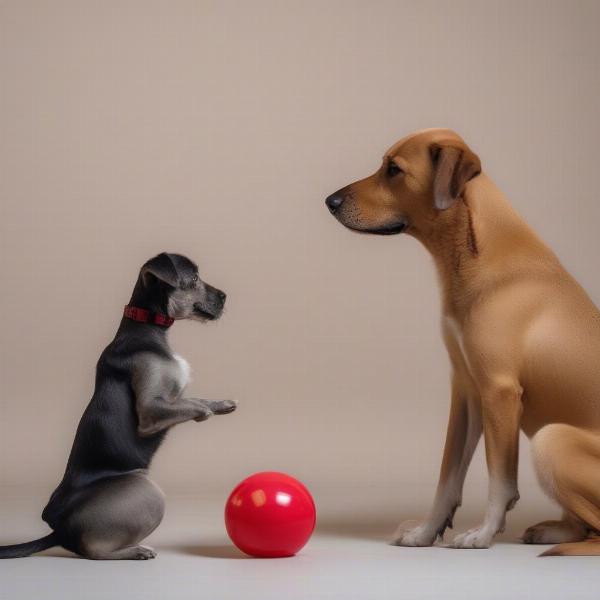Dog sibling rivalry is a common issue faced by many multi-dog households. It can manifest in various ways, from playful squabbles over toys to more serious aggression involving food or territory. Understanding the root causes of this rivalry and implementing effective management strategies are crucial for maintaining a harmonious home environment for all your furry family members. This article will explore the nuances of dog sibling rivalry and provide practical solutions to help you foster peace and cooperation within your pack.
Recognizing the Signs of Sibling Rivalry
Dog sibling rivalry isn’t always obvious. While some signs are overt, like growling, snapping, or fighting, others are more subtle. Keep an eye out for resource guarding, where one dog aggressively protects their food, toys, or even a favorite spot on the couch. Blocking access, staring, and stiff body posture are also common indicators of tension between dogs. Subtle signs can escalate quickly, so early intervention is essential.
 Dog Sibling Rivalry: Subtle Signs
Dog Sibling Rivalry: Subtle Signs
Why Does Sibling Rivalry Occur?
Several factors contribute to sibling rivalry in dogs. Competition for resources, like food, attention, and toys, is a primary driver. Changes in the household dynamic, such as the introduction of a new pet or baby, can also trigger rivalry. Differences in personality and play styles can exacerbate existing tensions. For example, a high-energy dog might overwhelm a more laid-back companion, leading to conflict. Understanding these underlying causes is the first step towards resolving the issue.
Establishing Clear Boundaries and Hierarchy
Establishing clear boundaries and a consistent routine can significantly reduce rivalry. Feed your dogs in separate areas to minimize competition over food. dogs fighting over food can be dangerous, and separate feeding spaces are crucial for preventing this. Provide each dog with their own toys and beds, and respect their individual space. While it’s important to show affection to all your dogs, avoid favoring one over the other, as this can fuel resentment.
Training and Behavior Modification
Training plays a vital role in managing sibling rivalry. Basic obedience commands, like “sit,” “stay,” and “leave it,” can help you control your dogs’ behavior and redirect their attention away from potential conflicts. Positive reinforcement techniques, such as rewarding desired behaviors with treats and praise, are highly effective. Consider working with a professional dog trainer who can assess your dogs’ specific needs and develop a personalized training plan.
Fostering Positive Interactions
While addressing the negative behaviors associated with rivalry is important, fostering positive interactions is equally crucial. Engage your dogs in activities they can enjoy together, such as walks, playtime, or even training sessions. This helps them build positive associations with each other and strengthens their bond. sibling rivalry in dogs can be mitigated with positive interactions and shared activities. Remember, patience and consistency are key to achieving lasting results.
When to Seek Professional Help
If the rivalry escalates into frequent or serious aggression, it’s essential to seek professional help from a certified veterinary behaviorist or experienced dog trainer. They can identify the underlying causes of the aggression and develop a behavior modification plan tailored to your dogs’ specific needs. Early intervention can prevent the situation from worsening and ensure the safety and well-being of all your pets. fostering older dogs can sometimes present challenges with sibling rivalry, and professional advice may be needed.
Conclusion
Dog sibling rivalry is a manageable issue with the right approach. By understanding the underlying causes, establishing clear boundaries, implementing consistent training, and fostering positive interactions, you can create a peaceful and harmonious home environment for all your furry family members. Remember, patience and consistency are essential for success. Don’t hesitate to seek professional help if you’re struggling to manage the situation on your own. Addressing dog sibling rivalry proactively will strengthen the bonds within your pack and ensure a happy and fulfilling life for all your canine companions.
FAQ
- How can I tell if my dogs are playing or fighting? Playful interactions typically involve relaxed body language, loose movements, and role reversals. Fighting, on the other hand, is characterized by tense body posture, aggressive vocalizations, and intent to harm.
- Is it normal for dogs to have occasional disagreements? Yes, occasional disagreements are normal, especially when resources are involved. However, frequent or intense conflicts require intervention.
- Can sibling rivalry be completely eliminated? While complete elimination may not always be possible, effective management strategies can significantly reduce rivalry and promote peaceful coexistence.
- Should I intervene every time my dogs have a disagreement? Not necessarily. Minor squabbles can sometimes be resolved without intervention. However, be ready to step in if the situation escalates.
- What if my dogs are constantly fighting over food? Feed them in separate areas, ensuring each dog has their own bowl and enough space to eat comfortably. dog treesome
ILM Dog is a leading online resource for dog owners worldwide, providing expert advice on all aspects of dog care and wellbeing. From breed selection and health to training and nutrition, ILM Dog is committed to helping you provide the best possible care for your canine companion. Whether you’re a seasoned dog owner or just starting out, ILM Dog offers valuable insights and practical tips to enhance your dog’s life. Contact us today for all your dog-related inquiries. Email: [email protected], Phone: +44 20-3965-8624. Visit ILM Dog for more information and expert advice.